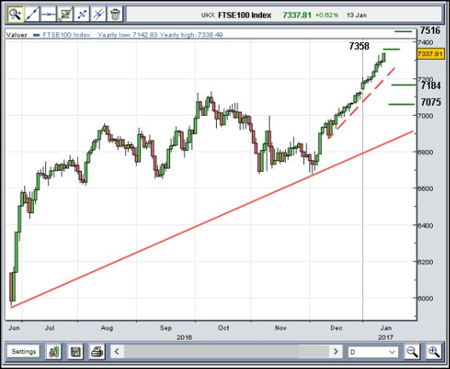How FTSE 100 can top 7,500
16th January 2017 09:47
by Alistair Strang from Trends and Targets
Share on
Will this be the week the sees 7,358? We've been banging on about this number all year and, with the market achieving a new "higher high" on Friday 13 January, hope continues to lurk in the corner.
In fact, the remorseless pace of small rises now permits a further ambition above 7,358! It's at 7,516 points.
If playing the long game and using a degree of common sense, the chart shows an uptrend since the start of last December. The FTSE would now need to slither below 7,215 to escape the immediate pace of ascent and, with the market closing the 13th at 7,337 points, this implies a pretty wide stop position.
But, of course, we're also projecting a further near-200-point rise.
If we work on the basis "something" causes a slowdown below 7,215, we can project a collapse toward 7,184 points initially with secondary, if broken, at 7,075 points.

Something a bit funny we've noted and it's one for the smart cookies. When the pound gets trashed against the US dollar, the FTSE generally has a pretty good day.
In a section for Trend and Targets clients only, we've published a report on GBP:USD and it warns of dangers for the pairing should it get below $1.1911.
If the contra movement on the FTSE happens, should GBP:USD wither below $1.1911, it's probably going to explain a new growth path happening to the 7,516 level on the FTSE.
Finally, the solid 'red' line on the chart is around the 6,900 point. The FTSE needs to break this to indicate the Brexit uptrend has failed. Visually, it appears unlikely.
This article is for information and discussion purposes only and does not form a recommendation to invest or otherwise. The value of an investment may fall. The investments referred to in this article may not be suitable for all investors, and if in doubt, an investor should seek advice from a qualified investment adviser.
Alistair Strang has led high-profile and "top secret" software projects since the late 1970s and won the original John Logie Baird Award for inventors and innovators. After the financial crash, he wanted to know "how it worked" with a view to mimicking existing trading formulas and predicting what was coming next. His results speak for themselves as he continually refines the methodology.